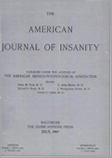Abstract
1. The neuropathic constitution is transmitted from generation to generation in the manner of a trait which is, in the Mendelian sense, recessive to the normal condition. Rules of theoretical expectation are accordingly as follows:
a. Both parents being neuropathic, all children will be neuropathic.
b. One parent being normal, but with the neuropathic taint from one grandparent, and the other parent being neuropathic, half the children will be neuropathic and half will be normal but capable of transmitting the neuropathic make-up to their progeny.
c. One parent being normal and of pure normal ancestry and the other parent being neuropathic, all the children will be normal but capable of transmitting the neuropathic make-up to their progeny.
d. Both parents being normal, but each with the neuropathic taint from one grandparent, one-fourth of the children will be normal and not capable of transmitting the neuropathic make-up to their progeny, one-half will be normal but capable of transmitting the neuropathic make-up, and the remaining one-fourth will be neuropathic.
e. Both parents being normal, one of pure normal ancestry and the other with the neuropathic taint from one grandparent, all the children will be normal, half of them will be capable, and half not capable of transmitting the neuropathic make-up to their progeny.
f. Both parents being normal and of pure normal ancestry, all the children will be normal and not capable of transmitting the neuropathic make-up to their progeny.
2. Various clinical neuropathic manifestations bear to one another the relationship of traits of various degrees of recessiveness; in a most marked way recoverable psychoses, though recessive as compared with the normal condition, are dominant over epilepsy and allied disorders.
3. Various other clinical neuropathic manifestations bear to one another the relationship of neuropathic equivalents; that is to say, they are conditions of the same degree of recessiveness varying in their clinical manifestations with the personality of the subject, environmental conditions, etc.
4. All the neuropathic children which result from a mating of the fourth type (both parents normal, but each with the neuropathic taint from one grandparent) can have theoretically only equivalent defects and not defects of different degrees of recessiveness.
5. Among the actual results from such matings the following have been met with:
a. Brothers and sisters suffering from clinically identical neuropathic manifestations.
b. Psychosis in one subject and peculiar or abnormal disposition, but no actual psychosis, in brothers or sisters.
c. Psychosis in one subject and isolated but clinically related symptoms in brothers or sisters; we find with particular frequency dementia præcox = fainting spells or convulsions in childhood.
d. Psychoses clinically not known to be related: senile deterioration = peculiar hysteriform psychoses.
6. Neuropathic conditions show only in about one-fourth of the cases indications for commitment to sanitariums or public institutions. The total incidence or neuropathic conditions may be roughly estimated as affecting between 1.5 and 2 per cent of the general population.
7. It is further estimated that about 30 per cent of the general population, without being actually neuropathic, carry the neuropathic taint from their ancestors and are capable under certain conditions of transmitting the neuropathic make-up to their progeny.

